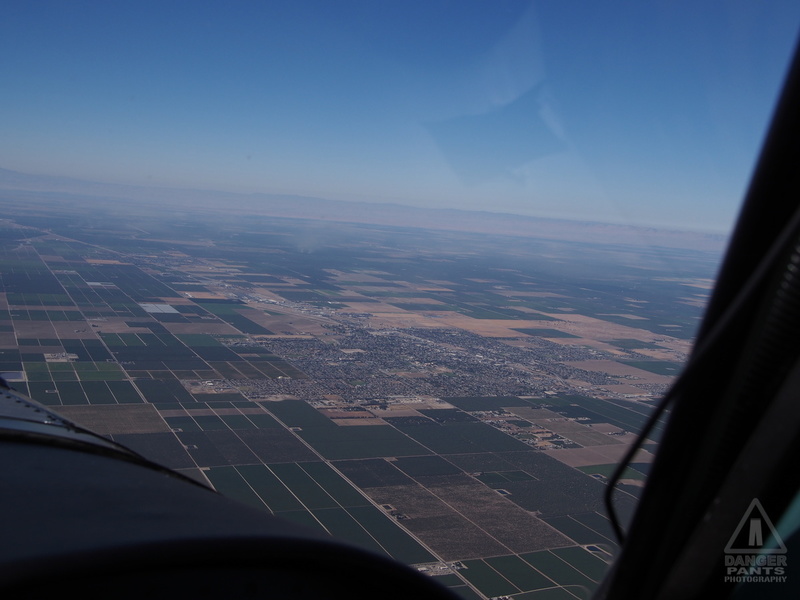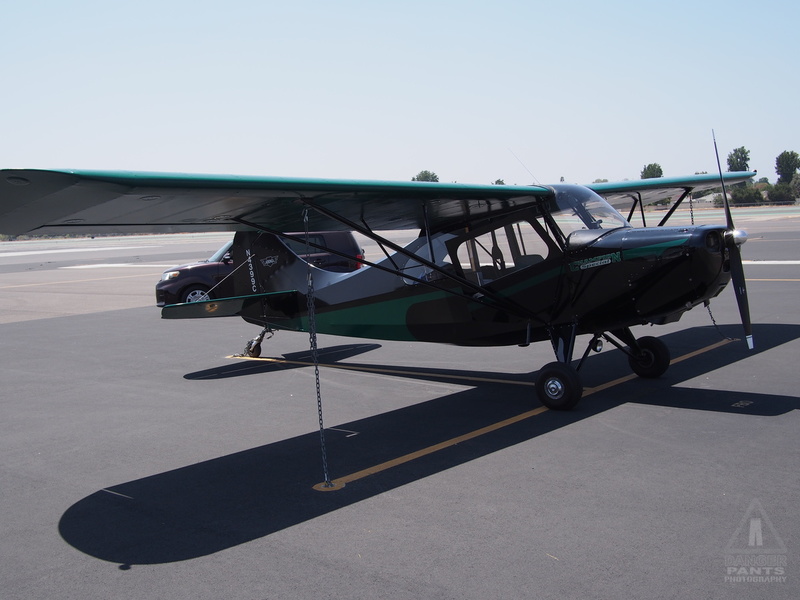Categories: all aviation Building a Biplane bicycle gadgets misc motorcycle theater
Sun, 20 Aug 2017
Seattle to LA, Episode 3: Over the Grapevine and Flying with David

The crop duster takes on his 500 gallons(!) of pesticide while Norbert wakes up
Previously: Flying from Ashland to Tulare, and flying a biplane
The Grapevine (as I understood it at the time -- research now suggests I've got the wrong name) is a range of mountains that stretches roughly east-west north of Los Angeles. As I chatted with the crop duster pilot that already-hot morning at Mefford Field in Tulare, CA, he casually mentioned, "Are you worried about going over the Grapevine?"
Well, I hadn't been, until he mentioned it.
I had, as expected, slept poorly at Mefford Field. Between the heat and the freeway noise (somewhat attenuated by wearing earplugs, but that introduced its own discomfort), I woke up frequently, and slept only lightly. Still, I did sleep, and I didn't feel particularly tired when the brightening sky woke me up around 6.
The other thing that had woken me up was some variety of large truck trundling by, its diesel engine loud against the backdrop of commuters on the freeway. It pulled up and parked nearby, and I figured it would be prudent to get up and see if I'd inadvertently parked the plane in the way of someone's activities for the day. A man popped his head around my plane, and I asked if I was in the way; he said no, but that they were about to make a whole lot of noise.
I arose to see a tanker truck parked 30 feet away, with a caged area in back where a man in white coveralls was already busily mixing something from slickly packaged white cardboard boxes. My suspicion was confirmed when one of the crop dusters rolled up, its big turbine motor screaming oddly as it idled. The gent in the coveralls dragged a big hose over and attached it to a port on the plane. Pesticides. I thought it was hilarious that they were packed up in very clean, white boxes with a colorful swoosh on the side, looking like packaging for shoes or industrial toilet paper more than semi-controversial chemicals.
I ended up chatting with the ground support guy and the pilot both, at different times. The ground guy was talkative, and was much easier to talk to, since the plane wasn't sitting there screaming for most of our chat. The pilot seemed very nice, though between his noise-cancelling headphones and my earplugs against the turbine noise, we said relatively little to each other.
Then he made his comment about crossing the Grapevine, and I started worrying that maybe I was taking the whole thing too lightly. I walked behind their hangar to escape the noise, and made my requisite call to Flight Services to check the weather.
It was great in the San Joaquin valley, where I was, but in the Los Angeles basin, there was a heavy overcast, and the briefer didn't think it would burn off until 11 am or later. It would take me most of my flying time before I would encounter the overcast, so this wasn't a huge deal, but it meant I couldn't really start the trip in earnest for a couple of hours from that point.
Mefford Field, although many things, was not a place I felt like hanging around for a few hours. I googled up "california airports with restaurants" or something, and found that Bakersfield Muni (L45) in Bakersfield had a cafe attached that sounded interesting: the Rocket Cafe. Bakersfield was just about an hour's flight from Tulare, so I packed myself up and alighted into the intangible aether at 9 am almost to the second.

A town amidst the fields, somewhere north of Bakersfield
The flight to Bakersfield was uneventful, and I passed the time by listening to Ruby 2, a somewhat inscrutable sci-fi radio drama from the 1980s that my brother and I used to listen to. Every so often, Bakersfield Approach or Norcal Approach would interrupt the story with a radio call, but since I've had the story memorized for decades, this was no real impediment.
Land in the San Joaquin valley seems to be largely given over to agriculture, which makes sense for an enormous flat plain with lots of sun and reasonable access to water. Occasional towns dot the landscape, connected by long threads of freeways.
Eventually Bakersfield hove into view, and I navigated around Meadows Field (BFL) to the smaller Bakersfield Muni, a few flight-minutes further south. I dropped down and taxied into the parking area for the Rocket Cafe.
The Cafe itself is a large room with a bar, many tables, and profuse displays of sports memorabilia. Pretty much what you'd expect from an airport bar. I ordered an omelette with hashbrowns and a glass of orange juice as I continued reading the pulp WWI book I'd picked up for my brother David, who's researching for a story set in an alternate WWI timeline.
An hour and a half after shutting down the engine, I was firing it up again, wondering how slow the takeoff would be in the heat of a Bakersfield summer day (about 100° F; answer: not substantially worse than all the other fields I'd departed in the high 90s). Breakfast sat comfortably in my belly, and the weather reports around LA had shown complete improvement, so there was nothing to stop me from continuing with the trip (but the air conditioning in the restaurant was sure nice, and I took the opportunity to charge a radio that had been doing excellent work).

I-5 running straight as an arrow toward the pass south of Bakersfield
As I flew toward the mountains, I realized that there was no way I was going to climb high enough to be comfortable before I reached them, so I started doing the flying equivalent of switchbacks, zig-zagging over the valley trying to gain altitude. I initially aimed for 7500 feet, but eventually climbed up to 9500 as the mountains loomed larger.
Because I was so high, the actual traversal of the mountains was completely uneventful, though Norbert's oil temperature was creeping higher with every climb, so I was keeping an eye on it in the heat. I tried to spot the handful of airports that the map showed were present, but only saw one or two. My ability to recognize airports improved noticeably during the trip, but Agua Dulce (L70) remained hidden to me.

The final pass, with LA in the hazy distance
I told my air traffic controller that I would start my descent as I passed over the final mountain toward Burbank, but he had me stay high to allow jet traffic to pass under me. That was an odd feeling, to be flying over the jets in a Champ. I had several altitude holds as I descended toward El Monte (EMT), my final destination. The LA airspace is quite busy.
Finally I was allowed down, and made the approach to El Monte. The tower told me to turn for the base turn into landing over the 210, but since I didn't know where that was (I was directly over it, as it happened), his explanation delayed me until it made more sense to make a straight-in approach. I landed at El Monte and shut down at 1:06 pm, 48 hours and six minutes, and 15.8 flight hours, after I'd departed Harvey Field in Snohomish.
Flying with David

Norbert on the ground at El Monte
My brother has never flown with me before. Since he lives in LA, and I live in Seattle, the factors have never come together before. Additionally, he's preparing to write a story about a plucky young woman who successfully flies a WWI era monoplane against all odds as part of her adventure, and I've been consulting with him on technical aspects of the airplanes and tech in the story. It was completely logical that we should go for a flight together to put some of the theory we'd been talking into practice.
We drove to the airport (a day and a half, and one very welcome shower, after my arrival), and I gave him the preflight speech as we drove. Which control does what, what to do in a variety of foreseeable emergencies, the order of events and what to expect, etc. We went over the plane, and I gave him a narrated preflight inspection. It was all good material for the book.
We strapped in and called the tower for takeoff clearance. I had reset the video camera to record full-speed video, so that he could have a visual reminder of what we'd done. Unfortunately it's not set up to record our intercom audio, which is too bad. We took off to the south, and followed the traffic pattern to depart the area to the northeast. The air was bumpy from all the heat rising off the pavement, though not unusually so.
I had forgotten, in the many years since we were children, that David used to get seasick on the sailboat we had. It briefly crossed my mind that morning, but I forgot to mention it in the preflight discussion. It turns out this sensitivity hasn't changed.
We flew over to the practice area east of El Monte, and discussed the various features on the ground. He mentioned he was feeling a bit ill, so I decided we would avoid the more strenuous maneuvers I'd been planning to demonstrate -- nothing aggressive, but steep turns can be tough on the ol' motion sickness.
I demonstrated a power-off stall (David's wife had given me a very disapproving look when I mentioned we'd try stalls, and I had to explain why it was safe, and wasn't as bad as it probably sounded; in brief, a stall makes the wings fly less efficiently, but if you do it a couple thousand feet in the air, it's simple to recover from, and offers basically no danger -- it's something every student pilot learns to do early on). I demonstrated a power-on stall. David said, "Oh, I think I'm gonna throw up," and I heard him anxiously opening up one of the airsick bags helpfully tucked into a little pocket directly in front of the passenger. The mic went quiet for a minute, then he returned, saying, "Ugh, but I feel better now."
We decided to return to the airport and land, to reassess if it made any sense to continue flying. We were quickly down, and David said he felt better, so I restarted the motor and we went up again, with the goal of giving him at least a few minutes of stick time. Before we'd even made it to pattern altitude, another bag came out, and I called the tower back to ask for a return to the lovely, stable ground.
He felt bad for cutting the flight short, but I assured him it was no trouble: through the previous owner's foresight, there were airsick bags ready for use, and the only downside to the adventure from my point of view was that I had two fewer airsick bags now. I felt bad that the motion was bad enough to make him sick, but there was no way to control it in that situation. It's too bad we didn't go flying on the previous, overcast day, simply because the air probably would have been calmer. But, as he said, hindsight is 20/20. He was still able to get up in the air, and despite getting ill, had a good time. Who knows, maybe his plucky young woman adventurer will also suffer a bout of airsickness, now.
Next: Can a Champ really fly from LA to Ashland in one day?
Posted at 19:57 permanent link category: /aviation
Categories: all aviation Building a Biplane bicycle gadgets misc motorcycle theater